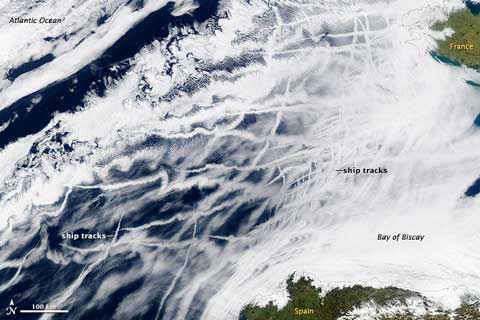 NASA was 50 years old last July, and the Earth Observatory has been celebrating by reviewing some of the classic images they’ve captured over the years. The image of the Earth at left was captured by Apollo 8 astronauts on December 22nd 1968 – one of the first “blue marble” pictures. Forty years on, it’s sobering to realise that only 24 people have seen the planet from this perspective – from the moon. But the picture that really caught my attention this week was part of a feature where NASA asked earth scientists what “unique insights” spaceflight had given us about the planet.
NASA was 50 years old last July, and the Earth Observatory has been celebrating by reviewing some of the classic images they’ve captured over the years. The image of the Earth at left was captured by Apollo 8 astronauts on December 22nd 1968 – one of the first “blue marble” pictures. Forty years on, it’s sobering to realise that only 24 people have seen the planet from this perspective – from the moon. But the picture that really caught my attention this week was part of a feature where NASA asked earth scientists what “unique insights” spaceflight had given us about the planet.

On page three, you’ll find this stunning image of “ship tracks” – the maritime equivalent of the contrails left by high flying aircraft – over the Bay of Biscay. If you ever doubted man’s influence on the atmosphere, here’s a dramatic confirmation of the large scale impacts brought about by our modern way of life. There are also satellite maps of ENSO sea level changes, Arctic sea ice decline, La Niña-related sea level changes, and many more pretty pictures. Educational eye candy.

What a stunning series of images, informative and lovely. I note that many of the clouds in view are natural, not man-made.
The text accompanying the ‘ship tracks’ image says: “The phenomenon of ship tracks is a clear signature of how burning fossil fuels modifies clouds. A cloud modified by the small particles released when fossil fuels are burned is brighter when viewed from the vantage point of space.”
I was wondering what ‘impacts’ you refer to and therefore what is confirmed; I can see three influences on temperature—one positive, two negative. I wonder how the combined factors, namely CO2, aerosols and higher albedo from increased, brighter cloud cover, influence temperature, or anything else.
It may well be that the (tiny) increased albedo plus the (tiny) cooling effect of the aerosols nicely and naturally offset the (infinitesimal) warming effect of the CO2 and other GH gases emitted by the engines.
Who knows? But it’s highly likely.
Also, because we don’t see similar, constant clouds over cities and other sources of internal combustion engine particulates, there must be other environmental factors involved here. So the picture may not be as simple, not as one-dimensional, as it might seem.
Best,
Richard Treadgold.
Ship tracks could have both a warming and a cooling impact – like most clouds. It depends where they are. It’s possible that cooling predominates, because one of the more feasible geoengineering suggestions is to use specially-equipped ships to generate very large ship tracks, thus increasing planetary albedo…
Don’t forget that clouds and aerosols won’t last as long as increased CO2 levels.